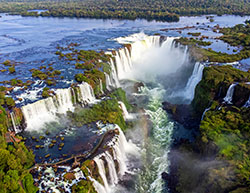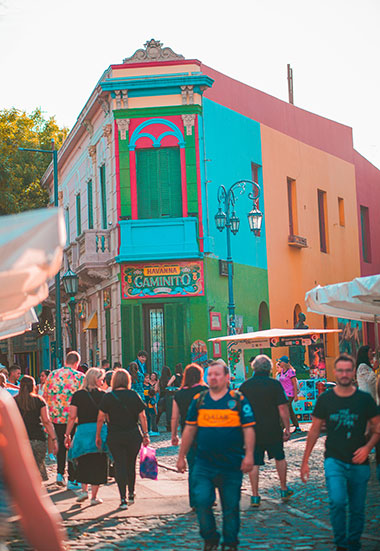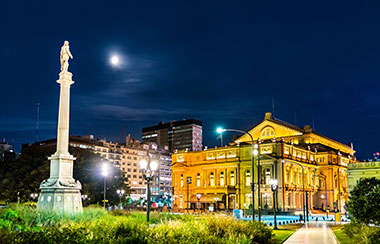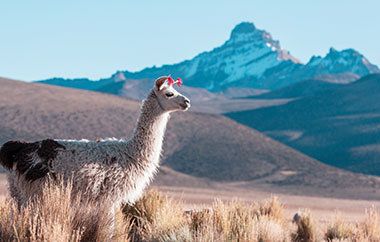Argentina
Enchanting Traditions and Natural Wonders
Argentina offers a wide range of vacation options from the Buenos Aires to the beautiful mountains and glaciers of Patagonia to the grandeur of Iguazu Falls and the renouned wineries of Mendoza there is something to discover in this diverse country.
Argentina
Buenos Aires, Argentina:

Photo by Bernardo Galmarini / Adobe Stock | Buenos Aires, the "Paris of South America," offers a diverse array of attractions. Immerse yourself in the city's passionate tango culture through dance lessons and live performances, savor traditional Argentine dishes and marvel at the grand architecture, from ornate palaces to renowned museums like Malba and Museo Nacional de Bellas Artes. Visit one of the many beautiful parks and gardens, such as the Parque Tres de Febrero and the Jardín Botánico.
|
Buenos Aires also has exceptional museums like the Museo de Bellas Artes and the Museo Evita. For some fresh air, take a boat ride on the Rio de la Plata and see the city from a different perspective or stroll through the beautifiul Recoleta Cemetery, the final resting place of many famous Argentinians, including Eva Perón and Jorge Luis Borges. Mix with the locals at the trendy Palermo Soho neighborhood, home to a variety of shops, cafes, and restaurants or visit the San Telmo Market, an open-air market where you shop for souvenirs and handicrafts. . You can also consider attending a tango show, indulging in shopping from upscale boutiques to street markets, and exploring other attractions.
Best Time to Visit:
September to November (Spring): 60-76°F (15-24°C) is a good time to visit Buenos Aires as it offers pleasant weather with blooming flowers and moderate temperatures, making it an ideal time for sightseeing and outdoor activities.
March to May (Fall): 57-73°F (14-23°C) - This is another excellent time to visit, with mild temperatures and fewer crowds.
December to March (Summer) High: 82°F (28°C) Low: 69°F (21°C) - Summers are characterized by hot and humid conditions, along with frequent thunderstorms. It's important to keep in mind that the humidity levels can be high during this season, which may feel hotter than the indicated temperatures. Rainfall typically occurs in short showers and isn't consistent every day. Despite this, there are many sunny days. This season offers various enjoyable activities, including visiting the beaches.
|
Patagonia, Argentina:

Photo by David Mark / Pixabay |
Patagonia is a haven for nature-loving retirees seeking tranquility and breathtaking vistas. The Patognia region is also shared with Chili, where the Torres del Paine National Park's the iconic Paine Towers are located. On the Argentina region of Patagonia is Los Glaciares National Park, home to the Perito Moreno glacier, one of the largest glaciers in the world.
|
The park also has a number of other beautiful mountains, glaciers, and lakes. The town of El Calafate is located near Los Glaciares National Park and is a popular base for exploring the park. Consider a scenic cruise through the Beagle Channel, located in the Tierra del Fuego archipelago, which is shared by Argentina and Chile. where you can spot penguins, seals, and whales, or embark on a gentle trek in Torres del Paine National Park to soak in the serenity of nature.
Best Time to Visit:
September to November (Spring): 40-60°F (5-15°C) - Spring brings milder weather, and it's the best time to see the region's landscapes come alive with colorful blooms.
December to February (Summer): 50-65°F (10-18°C) - Patagonia's summer offers the most extended daylight hours, making it ideal for outdoor adventures like hiking and wildlife spotting.
March to May (Fall): 40-60°F (5-15°C) - Argentina's Fall season is a beautiful time to witness the changing colors of Patagonia's forests and experience fewer tourists.
|
Iguazu Falls, Argentina:
 Photo by Brastock Images / Adobe Stock Photo by Brastock Images / Adobe Stock | Iguazu Falls, a UNESCO World Heritage site, is a spectacular display of nature's might. The power of these waterfalls is awe-inspiring as water cascades down over 275 separate falls, surrounded by lush rainforest. Retirees can explore the walkways and viewpoints to get up close to this mesmerizing natural wonder. For an adrenaline rush, take a thrilling boat ride under the falls or a helicopter tour to witness the grandeur from the sky.
|
Best Time to Visit:
September to November (Spring): 65-85°F (18-30°C) - Spring offers pleasant temperatures and lush foliage, making it a popular time to visit the falls.
December to February (Summer): 70-95°F (21-35°C) - Iguazu experiences its wettest and hottest weather during summer, providing impressive water flow at the falls but also higher humidity.
March to May (Fall): 65-85°F (18-30°C) - Argentina's Fall season offers milder temperatures and is a good time to visit to avoid the heat and crowds.
|
Mendoza, Argentina:
 Photo by Matt Broch /Unsplash Photo by Matt Broch /Unsplash | Mendoza offers an array of attractions such as its acclaimed wineries, natural hot springs at Cacheuta Thermal Baths or explore Aconcagua Provincial Park, home to the towering Mount Aconcagua. Cultural experiences abound at Museo Fundacional and Plaza Independencia, while culinary enthusiasts can join cooking classes and olive oil tours. versity and charm.
|
The Maipú region offers leisurely bike tours, and Mercado Central provides a taste of local market culture. For a touch of Argentine flair, tango shows are an exciting evening option
Best Time to Visit:
September to November (Spring): During spring, Mendoza enjoys temperatures ranging from 65°F to 85°F (18°C to 30°C), offering pleasant weather and vibrant foliage. This period is perfect for exploring the region's wineries and indulging in outdoor activities amidst the blossoming landscapes.
December to February (Summer): Mendoza's summer, from December to February, brings temperatures of 70°F to 95°F (21°C to 35°C). While this is the warmest and wettest time of the year, it's also when you can witness the impressive flow of the Andean snowmelt in the region's waterways and irrigation channels, contributing to the vitality of the vineyards.
March to May (Fall): Fall, from March to May, offers temperatures of 65°F to 85°F (18°C to 30°C). This season provides a respite from the heat and crowds, making it an optimal time to explore Mendoza's cultural sites, indulge in wine tours, and enjoy the mild climate.
|
Argentina's allure lies in its diverse landscapes, rich history, and warm hospitality. Retirees who venture to these top destinations can expect a memorable journey filled with cultural enrichment, natural wonders, and unforgettable memories.
Travel Planning Tips:
Best Time to Visit: The best time to visit Argentina varies by region and activity. For travelers over 50, consider the dry season, which typically falls between May and September. This is an ideal time for outdoor exploration, sightseeing, and cultural experiences. However, keep in mind that the southern hemisphere's seasons are opposite to those in the northern hemisphere.
Transportation:
Getting around: Argentina offers diverse transportation options catering to various preferences. Buses are a popular choice for their affordability and accessibility, connecting major cities and towns. They provide an opportunity to engage with the local culture and fellow travelers. Domestic flights can be a convenient option for covering long distances, especially for those looking to save time. Trains are available in certain regions and offer scenic journeys. Car rentals are also an option for exploring more remote areas at your own pace, allowing you to create a personalized itinerary.
Health and Safety Tips:
- Exercise caution regarding your personal belongings to prevent theft, especially in crowded tourist areas.
- Avoid wearing expensive jewelry or displaying valuable items to minimize the risk of attracting unwanted attention.
- When crossing streets, be vigilant as traffic regulations might not be strictly enforced.
- Opt for bottled water to stay hydrated and avoid consuming tap water, which may not be safe.
- Take precautions against mosquito-borne illnesses such as malaria and dengue fever. Use insect repellent and wear protective clothing to reduce the risk.
- Choose reputable transportation services or arrange transfers in advance, particularly when arriving at or departing from airports.
- Stay informed about the safety conditions in the regions you plan to visit and follow advice from local authorities.
- Respect visa regulations and adhere to permitted stay durations to avoid legal complications.
South America Travel Visa Requirements
It is crucial to adhere to immigration regulations and visa requirements while traveling in South America to ensure a smooth and hassle-free journey. Overstaying your visa can lead to serious consequences in some countries. Here are some tips to help you avoid any issues related to overstaying your visa:
- Know Your Visa Requirements: Before traveling to South America, thoroughly research the visa requirements for the specific countries you plan to visit. Each country has its own rules regarding entry, duration of stay, and visa extensions. Familiarize yourself with the visa regulations and ensure that you meet the necessary criteria.
- Check Visa Validity Period: Carefully review the validity period of your visa and make sure you understand the maximum duration of stay allowed. Some visas may have specific conditions or restrictions, such as a limit on the number of days or requirements for visa extensions. Be mindful of these details to avoid overstaying.
- Plan Your Itinerary: Plan your itinerary in advance and make sure it aligns with the duration of your visa. Consider the time you intend to spend in each country and calculate the number of days you will be staying. Allow for some buffer time to account for unexpected delays or changes in your travel plans.
- Monitor Your Visa Expiry Date: Stay vigilant about the expiration date of your visa. Mark it on your calendar or set reminders to ensure you are aware of when your visa is due to expire. Avoid leaving it until the last minute to address any necessary visa extensions or depart the country within the permitted timeframe.
- Seek Visa Extensions, if Needed: If you find yourself in a situation where you need to extend your visa due to unforeseen circumstances or changes in travel plans, contact the local immigration authorities or embassy of the respective country. Follow the proper procedures for visa extension and submit the required documentation within the designated timeframe.
- Consult with Local Authorities: If you have any doubts or questions regarding your visa status or duration of stay, seek assistance from local immigration authorities or reputable legal professionals. They can provide accurate information, guidance, and support to help you navigate the visa regulations effectively.
- Respect Local Laws and Customs: While traveling, it is essential to respect the local laws, customs, and regulations of the countries you visit. Engaging in any illegal activities or violating visa rules can have severe consequences. Stay informed about the local laws and abide by them to ensure a safe and enjoyable journey.
- Travel Advisories Stay updated on current events, local regulations, and any travel advisories when traveling abroad. Visit the US Government State Department Travel Advisories web site to check on the status of your destination.
- Enroll in the STEP Program: Travelers are also urged to enroll in the U.S. State Department's Smart Traveler Enrollment Program (STEP) to receive security messages and to make it easier to locate them in an emergency. The Department uses these security messages to convey information about terrorist threats, security incidents, planned demonstrations, natural disasters, etc. In an emergency, please contact the nearest U.S. Embassy or consulate or call the following numbers: 1 (888) 407-4747 (toll-free in the United States and Canada) or 1 (202) 501-4444 from other countries.
Remember, visa regulations and enforcement can vary from country to country. It is your responsibility as a traveler to comply with the immigration laws of the countries you visit. By being knowledgeable, proactive, and respectful of visa requirements, you can avoid any issues related to overstaying your visa and ensure a positive travel experience throughout South America.
| |
 La Boca, Buenos Aires Photo by Barbara Zandoval / Unsplash
 Buenos Aires, Argentina
Photo by Leonid Andronov
 Photo by Galyna Andrushko
|
 La Boca, Buenos Aires
La Boca, Buenos Aires Buenos Aires, Argentina
Buenos Aires, Argentina Photo by Galyna Andrushko
Photo by Galyna Andrushko